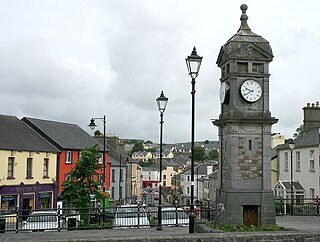
Earl of Rosse is a title that has been created twice in the Peerage of Ireland, both times for the Parsons family.

Boyle is a town in County Roscommon, Ireland. It is located at the foot of the Curlew Mountains near Lough Key in the north of the county. Carrowkeel Megalithic Cemetery, the Drumanone Dolmen and the lakes of Lough Arrow and Lough Gara are also close by. As of 2016, the population of the town was 2,568.
Anthony Lefroy was an Irish Conservative Party MP in the United Kingdom Parliament.
Ballymore Castle in Lawrencetown, County Galway, Ireland was originally a 15th-century tower house belonging to O'Madden. A house was added in 1620, and the castle has been much altered since then.

Moydow is a village on the outskirts of Longford Town in County Longford, Ireland.

Edward Robert King-Harman was an Irish landlord and politician. He sat in the House of Commons of the United Kingdom between 1877 and 1888 as an Irish nationalist, and later Unionist, Member of Parliament.
John William Plunkett, 17th Baron of Dunsany was an Anglo-Irish Conservative politician and peer.

Theobald Dillon, 7th Viscount Dillon of Costello-Gallin supported King James II, was attainted on 11 May 1691, and fell in the Battle of Aughrim during the Williamite War. His attainder was reversed in favour of the 8th Viscount on 20 June 1694.
General Robert Edward King, 1st Viscount Lorton, styled The Honourable from 1797 to 1800, was an Anglo-Irish peer and politician. He was notable for his strong support for anti-Catholic policies and his close association with the Orange Order.

Newton Hall is an 18th-century country house at Newton on the Moor, near Alnwick, Northumberland, England. It is a Grade II listed building.
Liam Mulvihill is an Irish retired Gaelic games administrator. He served as Director-General of the Gaelic Athletic Association from 1979 until 2008.

Sir Thomas Robert Tighe Chapman, 7th Baronet, was an Anglo-Irish landowner, the last of the Chapman baronets of Killua Castle in County Westmeath, Ireland. For many years he lived under the name of Thomas Robert Lawrence, taking the name of his partner, Sarah Lawrence, the mother of his five sons, one of whom was T. E. Lawrence, 'Lawrence of Arabia'.
Lawrence Harman Parsons, 1st Earl of Rosse, known as The Lord Oxmantown between 1792 and 1795 and as The Viscount Oxmantown between 1795 and 1806, was an Irish peer and politician.

The Newcomen Baronetcy, of Kenagh in the County of Longford, was a title in the Baronetage of Ireland. It was created on 30 December 1623 for Robert Newcomen. Born in London, the third son of Charles Newcomen and Jane Nightingale, Robert had come to Ireland in the late sixteenth century. He settled at Keenagh in County Longford, where he became a substantial landowner, and sat in the Irish House of Commons for Kilbeggan. By his first wife Katherine Molyneux, daughter of Sir Thomas Molyneux, Chancellor of the Exchequer of Ireland, he had twenty- one children, including the second, third and fourth Baronets. The sixth, seventh and eighth Baronets also represented County Longford in the Irish House of Commons. The eighth Baronet also represented Longford Borough in Parliament. The title became extinct on his death on 27 April 1789.
Thomas Marlay (c.1680–1756) was an Irish politician and judge, who ended his career as Lord Chief Justice of Ireland. He is remembered chiefly for beginning the rebuilding of Celbridge Abbey, and as the grandfather of the statesman Henry Grattan.
Lough Rynn Castle is a luxury castle hotel on the shores of Lough Rynn in County Leitrim, Ireland situated on the historic grounds of the medieval castle and estate of the Mac Raghnaill family of Muintir Eolais.
Lieutenant-Colonel Edward William Pakenham was an Irish soldier and Conservative Party politician from County Antrim. He served for two years as a Member of Parliament (MP), until his death in the Crimean War.
Cutts Harman (1706–1784) was an 18th-century Anglican priest in Ireland.
Sir Cecil William Francis Stafford-King-Harman, 2nd Baronet was an Anglo-Irish landowner and soldier. He was born Cecil Stafford, the second son of Sir Thomas Stafford, 1st Baronet and his wife Frances Agnes, daughter of Edward King-Harman. In 1933 Cecil added his mother's surname to his father's. His elder brother, Edward Charles Stafford King Harman, was killed in the First World War.
Hercules Langford Rowley PC was an Irish politician and landowner.







